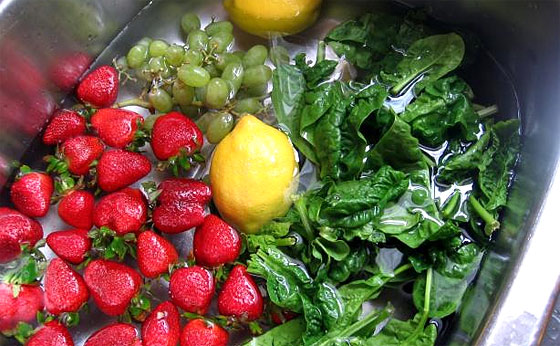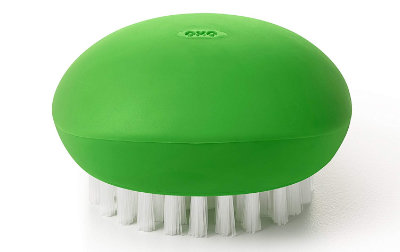Ratio of White Vinegar & Water | Kill Germs on Fresh Vegetables

It’s difficult or impossible to know where your fruits and vegetables are coming from as they sit on the grocery store shelves. They may look clean, but they might be contaminated with germs – just waiting to get you sick. How many people handled those vegetables?!
After reading the article, “Health Warning: Be Aware Where Your Vegetables Came From…”, you may seriously want to consider washing and cleaning your fruits and vegetables with a white vinegar mixture to help reduce the risk of germs and contamination.
Apparently every year, nearly 50 million people become ill from food contamination, including sickness caused by contaminated fruits and vegetables. Cleaning fruits and vegetables with vinegar helps kill bacteria to help ensure they are safe for consumption.
Here is the recommended vinegar and water solution mixture:
Ratio Of Vinegar And Water To Kill Germs On Vegetables
1 part white vinegar
3 parts water
1 part white vinegar with 3 parts water.
Example: To make a vinegar and water vegetable bath, use 1 cup white vinegar with 3 cups clean fresh water. Adjust amounts according to your needs.
Pro Tip: Fill a spray bottle with the vinegar and water solution. Keep it handy on the kitchen counter for vegetable decontamination (spray on).
Smooth Skinned Produce:
For ‘smooth skinned produce’, mist the fruit or vegetable, thoroughly coating its exterior with the vinegar solution. Then allow the produce to rest for 30 seconds before rubbing its surface and rinsing it under cold, running water.
The FDA recommends cleaning smooth-skinned fruits and vegetables by gently rubbing them with your hands (instead of an abrasive scrubber). This prevents you from breaking the skin before the fruit or vegetable is completely clean, which could expose the flesh to contaminants.
Rough Surfaced Produce:
For ‘rough surfaced produce’ (e.g. broccoli, cauliflower, leafy greens, melons, potatoes, berries and other produce without a smooth or soft surface). They require a soaking in a 1 to 3 mixture (1 part vinegar and 3 parts water) in a large bowl. This ensures the acidic blend kills all bacteria.
For leafy greens or other similar produce, you will need to separate the individual leaves for thorough cleaning. After soaking for several minutes (some recommend up to 15 to 20 minutes), rinse them under running water.
Tip: You may also use regular household bleach with the following formula mixture:
Chlorine Bleach For Sanitizing Raw Fruits And Vegetables
While it’s easy to simply trust your grocer and supply chain, the fact is that there’s likely many handling steps from beginning to end. All it takes is just once to become very ill from contaminated produce!
This is the exact vegetable scrub brush that I use:

Check it out on amz:
OXO Good Grips Flexible Vegetable Brush
Stock Up On White Vinegar
It’s cheap! And it’s very useful!
“Commercially produced vinegar has a virtually indefinite shelf life”, says the Vinegar Institute, an association that represents most of the world’s largest vinegar manufacturers.
How Long Does Vinegar Last?
The Vinegar Institute conducted studies to find out and confirmed that vinegar’s shelf life is almost indefinite. Because of its acid nature, vinegar is self-preserving and does not need refrigeration. White distilled vinegar will remain virtually unchanged over an extended period of time. And, while some changes can be observed in other types of vinegars, such as color changes or the development of a haze or sediment, this is only an aesthetic change. The product can still be used and enjoyed with confidence.
Continue reading: Practical Uses For Vinegar

